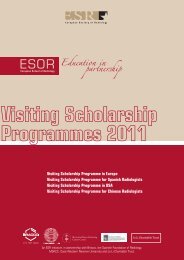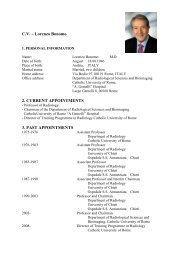Postgraduate Educational Programme - myESR.org
Postgraduate Educational Programme - myESR.org
Postgraduate Educational Programme - myESR.org
- No tags were found...
You also want an ePaper? Increase the reach of your titles
YUMPU automatically turns print PDFs into web optimized ePapers that Google loves.
<strong>Postgraduate</strong> <strong>Educational</strong> <strong>Programme</strong>A-064 09:20DiscussionT.H. Helbich 1 , H.J. de Koning 2 ; 1 Vienna/AT, 2 Rotterdam/NLThe discussion will address the following issues:1. Why do estimates of overdiagnosis differ?2. Should we begin to think about stopping mammographic screening?3. How to reduce overdiagnosis?4. DCIS as major part of overdiagnosis.5. How should we inform women about overdiagnosis?08:30 - 10:00 Room D2Emergency RadiologyRC 417ER: basic principlesModerator:P. Valdés Solís; Marbella/ESA-065 08:30A. Logistics and <strong>org</strong>anisation of an emergency radiology departmentM. Körner; Landshut/DE (markus@dr‐koerner.net)The interest in emergency radiology has been growing over the last years. TheEuropean Society for Emergency Radiology is still young, and their first summermeeting in Munich in 2012 was a huge success, which is a strong indicator for theinterest in this subspeciality. Besides optimising technical equipment and protocolsfor imaging, different logistic concepts have to be considered in planning and<strong>org</strong>anizing emergency radiology departments. First of all, logistic concepts haveto be considered for having an optimal workflow: the radiology department hasto be in close proximity to the emergency department and the admitting area, inparticular. The whole workflow must be optimised for speed and accuracy. This alsomandates to have dedicated and standardised examination and viewing protocolsfor CT. In contrast to the USA, where dedicated emergency radiology departmentsare well established, the reading of emergency radiology cases is still frequentlydone by non-specialized radiologists in European countries. The radiologic staffinvolved has to be trained for interpretation of trauma and other emergent cases.This does not only account for residents but also for consultants and attendingradiologists as well. Since a large number of such cases will arrive during afterhours and on weekends, staffing has to be adjusted to this fact, which includesattending radiologists to be available during these hours on call or, preferably,on-site. This lecture will give an overview of logistic concepts, <strong>org</strong>anization of anemergency department and will also discuss critical issues in polytrauma imaging.Learning Objectives:1. To understand how an emergency radiology department should be <strong>org</strong>anised.2. To become familiar with the logistics, staffing and technical equipment of anER department operating 24/7.A-066 09:00B. Advanced trauma life support: basic knowledge for radiologistsD.R. Kool; Nijmegen/NL (dignakool@gmail.com)Advanced trauma life support® (ATLS®) is an established systematic approachassessing trauma patients prioritizing the most life-threatening injuries. The term‚golden hour‘ is used to emphasize a sense of urgency, not to define a set timeframe. The assessment is divided in a primary and a secondary survey. In theprimary survey, the mnemonic ABCDE (Airway, Breathing, Circulation, Disability,Exposure and Environment) is used to guide the order of assessment. For efficientcommunication, it is helpful to report imaging in a comparable order. Although imagingshould not postpone treatment, chest and pelvis radiographs and abdominal UScan influence treatment decisions and should be performed in the primary survey.In the secondary survey, the patient is examined from head to toe and appropriateadditional radiographs are performed. According to ATLS® and contrary to literatureevidence, CT plays a minor role in the evaluation of trauma victims and indicatedCT scans should be done in the secondary survey. Although improved in the mostrecent edition, the ATLS® is neither evidence-based nor up-to -date concerningimaging in trauma settings. However, surgeons use the ATLS® recommendationsroutinely to support indications for diagnostic imaging. In addition, surgeons referto ATLS® in error with indications for imaging that are not supported by the presentATLS® guideline or radiological literature. In this refresher course, the rationale andindications of imaging will be assessed where it pertains to the ATLS® protocol.The principles of ATLS® and discrepancies between the radiological literature,ATLS® and day-to-day practice will be addressed.Learning Objectives:1. To understand the relationship between ATLS and emergency radiology.2. To know more about the rational use of CR, US and CT according to patientpriorities in the emergency setting.3. To become familiar with priority-oriented reporting of findings.A-067 09:30C. Mechanism of injury and MDCT protocols: choosing the rightprotocol for the right patientS. Voelckel 1 , M. Rieger 2 ; 1 Innsbruck/AT, 2 Hall in Tirol/AT(sandra.voelckel@i‐med.ac.at)Polytrauma is the leading cause of death in younger people. Because of the broadconsensus on the time sensitivity of the very first emergency procedures, namely“time is life”, radiologists constantly attempt to devise new ways to reduce theamount of time needed to adequately image trauma victims while simultaneouslyimproving image quality. Multidetector-row computed tomography (MDCT) is consideredan accurate and reliable imaging modality for initial evaluation of patients withmultiple injuries and is widely used in modern emergency radiology. In patients withhaemodynamic and respiratory instability that is not appropriate for CT examination,the delay in the first emergency room phase is used for conventional radiographsand a comprehensive sonogram. Knowledge of trauma mechanism is essentialto adapt the ideal diagnostic protocol. Choosing a surgical treatment strategy forpatients with traumatic extremity injuries requires rapid detection, localisation, andcharacterisation of a possibly accompanying vascular injury. In these patients, aMDCT-angiography is included in the standard whole body protocol. Blunt cervicalvascular injuries (BCVI) represent serious conditions with an increased risk of beinginitially underdiagnosed during the first patient management. If present, BCVI, e.g.,arterial dissections, potentially can cause severe or even fatal cerebral damage.Therefore, a MDCA-angiography of the cervical arteries should be included in thestandard work-up.Learning Objectives:1. To understand mechanisms of traumatic injuries.2. To become familiar with established whole body MDCT protocols and theirpossible relation to injuries.3. To know the impact of MDCT findings on patient management.08:30 - 10:00 Room E1State of the Art SymposiumSA 4Diffusion-weighted imaging (DWI) of the abdomenA-068 08:30Chairman’s introductionY. Menu; Paris/FR (yves.menu@sat.aphp.fr)Diffusion-weighted imaging (DWI) is a very hot topic, because it comes withstructural and physiological information, added to morphology. As the techniquebecomes mature, and as most of MRI machines are able to acquire DWI, it is increasinglypopular and the number of indications extends continuously. However,there are still unanswered or partially answered questions: should we integrateDWI sequences in every single abdominal examination? How standard are theacquisition technique and ADC measurements? Does it improve the lesion detectionand/or characterisation? Is there any benefit in predicting or evaluating diseaseresponse to treatment, whether inflammation or tumour? Can it compete with PETfor detection and/or characterisation? In this session, the basic principles and toolsfor interpretation of DWI will be addressed, with a focus on abdominal <strong>org</strong>ans. Atthe end of the session, the speakers will comment on clinical cases provided by theModerator:, in order to provide the attendees with clear and practical messages.Session Objectives:1. To understand DWI principles.2. To learn about appropriate protocols for DWI of the abdomen.3. To learn how to analyse and report DWI images.4. To understand the clinical value of DWI for detection, characterisation andprognostic evaluation.S22AB C D E F G













